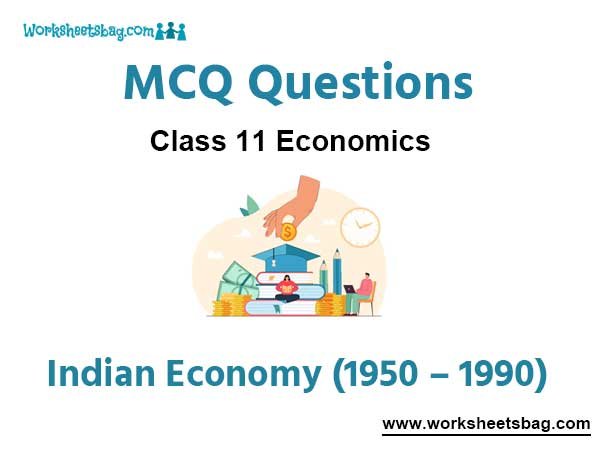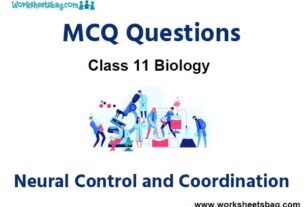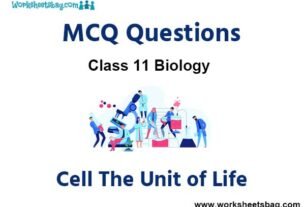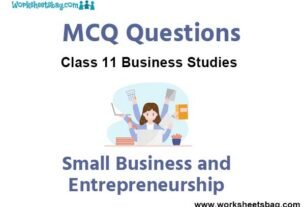Please refer to MCQ Questions Chapter 2 Indian Economy (1950 – 1990) Class 11 Economics with answers provided below. These multiple-choice questions have been developed based on the latest NCERT book for class 11 Economics issued for the current academic year. We have provided MCQ Questions for Class 11 Economics for all chapters on our website. Students should learn the objective based questions for Chapter 2 Indian Economy (1950 – 1990) in Class 11 Economics provided below to get more marks in exams.
Chapter 2 Indian Economy (1950 – 1990) MCQ Questions
Please refer to the following Chapter 2 Indian Economy (1950 – 1990) MCQ Questions Class 11 Economics with solutions for all important topics in the chapter.
MCQ Questions Answers for Chapter 2 Indian Economy (1950 – 1990) Class 11 Economics
Question. What is needed to provide protection against natural calamities like floods, drought, locusts, thunderstorms, etc.?
a) Multiple cropping
b) Green revolution
c) Crop insurance
d) HYV
Answer
C
Question. The economy in which Central Authority plans all the important activities can be termed as
a) Mixed Economy
b) Socialist Economy
c) Capitalist Economy
d) Developing Economy
Answer
B
Question. ______ spells out how the resources of a nation are put to use
a) Plan
b) Feedback
c) Economic system
d) Policy
Answer
A
Question. The objective of equity can be achieved by:
a) reducing gap between rich and poor
b) reducing poverty
c) Both a) and b)
d) None of the above
Answer
C
Question. Equity aims at
a) Equitable distribution
b) Economic growth
c) Modernization
d) All of the above
Answer
A
Question. Which one of these is a central problem of an economy?
a) What to produce
b) How to produce
c) When to produce
d) For whom to produce
Answer
A.B.D
Question. Which one of the following , is not a goal of the Planning Commission ?
a) Economic Growth
b) Equity
c) Resource conservation
d) Self-reliance
Answer
C
Question. When was the Planning Commission set up in India?
a) 1952
b) 1950
c) 1964
d) 1975
Answer
B
Question. When was NITI Aayog established?
a) 1991
b) 2001
c) 2011
d) 2015
Answer
D
Question. Which of the following is not a goal of five year plan ?
a) Growth
b) Equity
c) Land reforms
d) Modernisation
Answer
C
Question. _______ economy is the economy in which means of production are owned, controlled and operated by the government.
a) Mixed
b) Socialist
c) Capitalist
d) None of these
Answer
B
Question. First time the objective of self-reliance was incorporated in the ____ Five year plan
a) First
b) Second
c) Third
d) Fifth
Answer
C
Question. The portion of agricultural produce which the farmer actually sells in the market after satisfying his domestic need is called
a) Profitable
b) Marketed Surplus
c) Cost surplus
d) None of the above
Answer
B
Question. New Agricultural strategy was also knows as:
a) While revolution
b) Agricultural revolution
c) Green revolution
d) Land revolution
Answer
C
Question. Small scale industries today defined as all those industries in which maximum investment is
a) Less than Five Lakh
b) Less than Ten Lakh
c) Twenty Crore
d) Less than ten Crore
Answer
D
Question. Infant mortality rate fall due to
a) Better health facilities
b) No change in health facilities
c) Poor health facilities
d) All of these
Answer
A
Question. _______ refers to means avoiding imports of goods which could be produced in India
a) Equity
b) Modernization
c) Self reliance
d) Economic growth
Answer
C
Question. The four goals of five-year plans include which of the following
a) Growth ;
b) Modernization
c) Self-reliance
d) All of the above
Answer
D
Question. Small scale units are differentiated from large scale units on the basis of:
a) Volume of output
b) Amount of investment
c) Volume of sale
d) Size of unit area
Answer
B
Question. Capitalist Economy is controlled and operated by:
a) Private sector
b) Public sector
c) Both a) and b)
d) Neither a) nor b)
Answer
A
Question. The licensing policy aimed at
a) Promoting regional equality
b) check undue expansion of industrial sector
c) bothe a) and b)
d) None of the above
Answer
C
Question. Rate of economic growth is measured by rate of change in:
a) Nominal GDP
b) Read GDP
c) DP at current price
d) Any one of the above
Answer
B
Question. What does HYVP stand for?
a) High Yielding Varieties Products
b) High Yielding Various Programme
c) High Yielding Varieties Programme
d) High Yielding Various Products
Answer
C
Question. Which of the following is the main objective of carrying out various economic activities?
a) Profit
b) Public welfare
c) Competition
d) Equality
Answer
B
Question. In which year, Industrial Policy Resolution was adopted?
a) 1956
b) 1950
c) 1965
d) 1953
Answer
A
Question. For the growth of___________, use of HYV seeds was beneficial.
a) Rice
b) Barley
c) Wheat
d) Pulses
Answer
C
Question. The portion of agricultural produce that is sold in the market by farmers is known as.
a) Trade deficit
b) Marketed surplus
c) Subsidy
d) Import substitution
Answer
B
Question. How much percent of India’s population was dependent on agriculture during independence?
a) 75%
b) 50%
c) 85%
d) 65%
Answer
A
Question. Life expectancy in 1991 was
a) 63 year
b) 62 year
c) 61 year
d) 65 year
Answer
C
Question. In 1950-1951,gross area under cultivation was ___crore hectare which now has shot up to __crore hectare.
a) 15,17
b) 13,19
c) 10,20
d) None of the above
Answer
B
Question. Which one of the following measures was not a part of tenancy reforms?
a) fixation of land ceiling
b) regulation of rent
c) ownership rights for tenants
d) security of tenure
Answer
A
Question. All the state government imposed land ceiling in 1960 except
a) North-western
b) North-eastern
c) South-eastern
d) South-western
Answer
B
Question. When was the National Development Council (NDC) set up as an adjunct to the Planning Commission?
a) 1950
b) 1969
c) 1952
d) 1979
Answer
C
Question. Planning commission was set up in which year in India?
a) 5th March, 1951
b) 25th April, 1951
c) 20th March, 1951
d) 15th March, 1950
Answer
D
Question. Who is the ex-officio chairman of the planning commission
a) Governor
b) President
c) Vice-President
d) Prime Minister
Answer
D
Question. Difference in export and import is known as
a) BOA
b) BOT
c) BOC
d) BOP
Answer
B
Question. To protect goods produced in India from imports, Government made use of
a) Quotas
b) Tariffs
c) Export Promotion
d) All of these
Answer
A.B
Question. Schedule __ comprise of industries which would be exclusively owned by the state.
a) A
b) B
c) C
d) None of these
Answer
A
Question. In India exports are encouraged through
a) Any one of these
b) Relief in taxes
c) Subsidies
d) Concessional bank credit
Answer
A
Read the following statement given below and choose the correct alternative
Question. Assertion(A)- After independence, India adopted inward looking trade strategy which is called import substitution
Reason ( R)- Import substitution was highly regulatory and restrictive in nature
a) Both assertion and reason are true. Reason is the correct explanation of assertion
b) Both assertion and reason are true. Reason is not the correct explanation of assertion
c) Assertion is true but reason is not
d) Reason is true but assertion is not
Answer
B
Read the following statement given below and choose the correct alternative
Question. Assertion ( A)- Economic planning means coordination and utilisation of available resources in an economy
Reason ( R)- Economic planning is undertaken by the private sector in an economy
a) Both assertion and reason are true. Reason is the correct explanation of assertion
b) Both assertion and reason are true. Reason is not the correct explanation of assertion
c) Assertion is true but reason is not
d) Reason is true but assertion is not
Answer
C
Read the following statement given below and choose the correct alternative
Question. Statement 1- Small scale industries are more capital intensive
Statement 2- Industrial policy resolution formed the basis of second five year plan
a) Both are correct
b) Both are incorrect
c) Statement 1 is correct and statement 2 is incorrect
d) Statement 1 is incorrect and statement 2 is correct
Answer
D
Read the following statement given below and choose the correct alternative
Question. Statement 1- Small scale industries were important for employment generation
Statement 2- Small scale industries contributed in foreign trade
a) Both are correct
b) Both are incorrect
c) Statement 1 is correct and statement 2 is incorrect
d) Statement 1 is incorrect and statement 2 is correct
Answer
A



